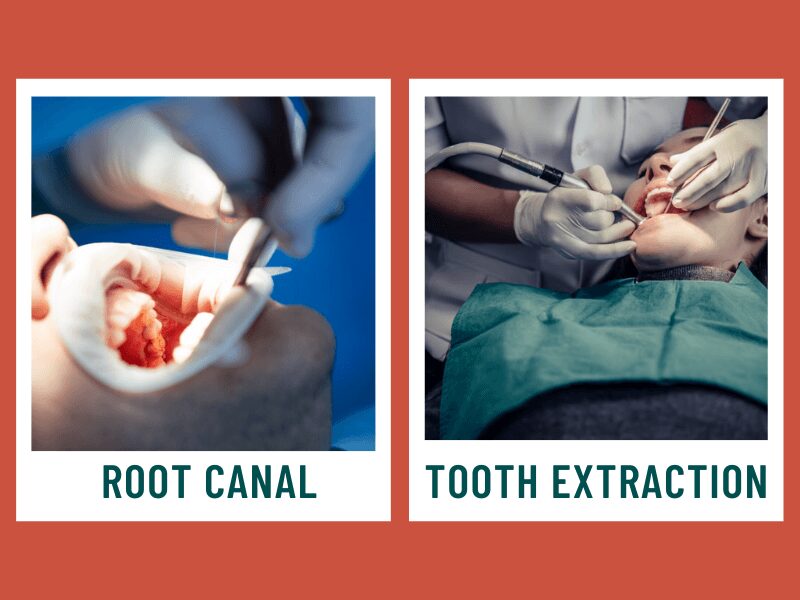Your dental health significantly impacts your overall well-being, affecting everything from eating comfortably to smiling confidently. When a tooth becomes severely damaged or infected, prompt treatment is essential; untreated dental problems can spread infection and cause serious complications.
Two primary procedures address damaged or infected teeth: root canal therapy and tooth extraction. The root canal vs tooth extraction decision determines whether you keep your natural tooth or have it removed entirely. A root canal saves your tooth by removing infected pulp tissue, while extraction removes the complete tooth from its socket.
This guide compares these procedures across costs, recovery time, and long-term outcomes, helping you make an informed decision with your dentist about the best treatment for your situation.

| Aspect | Root Canal | Tooth Extraction |
| Purpose | Saves the natural tooth by removing infected pulp | Removes the entire tooth |
| Procedure Duration | 1-2 hours, may require multiple visits | 20-40 minutes, usually one visit |
| Recovery Time | 1-2 weeks, mild discomfort | 1-2 weeks, potential for more discomfort |
| Cost | Higher ($700-$1,500) | Lower ($75-$300) |
| Long-Term Impact | Preserves natural tooth, maintains bite | May require replacement (implant, bridge) |
| Pain Level | Moderate, managed with anesthesia | Moderate to high, depending on complexity |
| Best For | Savable teeth with infected pulp | Severely damaged or unsavable teeth |
What Is a Root Canal Treatment?
A root canal is an endodontic procedure designed to save a tooth that has become infected or severely damaged. During this treatment, your dentist or endodontist removes the infected or inflamed pulp from inside the tooth’s root canal system, cleans and disinfects the area, then fills and seals it to prevent future infection.
The procedure typically involves several carefully coordinated steps. First, your dentist administers local anesthesia to numb the area completely, ensuring you remain comfortable throughout the treatment. Next, they create a small opening in the tooth’s crown to access the infected pulp chamber. The damaged pulp tissue is then carefully removed using specialized instruments. After removal, the dentist thoroughly cleans and shapes the root canals to eliminate any remaining bacteria. Once cleaned, the canals are filled with a biocompatible material called gutta-percha, and the tooth is sealed. In most cases, a crown is placed over the treated tooth for added protection and to restore full function.
Root canal treatment has proven remarkably successful, with success rates ranging from 85-97%. This high success rate makes it a reliable option for preserving natural teeth and avoiding extraction. Modern techniques and technology have made the procedure more comfortable and efficient than ever before, often completing treatment in just one or two visits.
What Is a Tooth Extraction?
Tooth extraction involves the complete removal of a tooth from its socket in the jawbone. This procedure becomes necessary when a tooth is too damaged, decayed, or compromised to be saved through other treatments like root canal therapy.
Dentists perform two types of extractions depending on the tooth’s condition and position. A simple extraction is performed on visible teeth above the gum line using local anesthesia. During this procedure, the dentist loosens the tooth with an instrument called an elevator, then carefully removes it with forceps. This type of extraction typically takes 20-40 minutes and causes minimal trauma to surrounding tissues.
Surgical extraction is required for teeth that haven’t erupted fully or have broken off at the gum line. This more complex procedure may require incisions in the gum tissue and sometimes removal of surrounding bone to access the tooth. Surgical extractions take longer and may require sedation beyond local anesthesia for patient comfort.
Dentists typically recommend extraction when root canal treatment isn’t viable or when the tooth poses ongoing health risks. Common reasons include severe decay that has destroyed most of the tooth structure, advanced gum disease affecting the tooth’s stability, fractures extending below the gum line, or overcrowding requiring tooth removal for orthodontic treatment.
Key Differences: Root Canal vs Tooth Extraction Explained
Purpose and Outcome
The fundamental difference between these procedures lies in the end result. A root canal preserves your natural tooth structure, maintaining the integrity of your smile and bite alignment. Your original tooth remains in place, continuing to function as it always has. Tooth extraction, conversely, removes the problem tooth entirely, creating a gap that may need replacement to prevent future complications.
Complexity and Time Investment
Root canal procedures require more intricate work, often taking 1-2 hours per appointment with possible follow-up visits for crown placement. The dentist must carefully navigate the tooth’s internal canal system, which can be complex, especially in molars with multiple roots. This precision work ensures complete removal of infected tissue and proper sealing to prevent reinfection.
Tooth extraction is comparatively straightforward for most cases, typically completed in 20-40 minutes during a single visit. Simple extractions require less time and technical complexity, though surgical extractions of impacted or broken teeth may take longer and require additional healing time.
Cost Considerations
Root canals cost between $700-$1,500, depending on tooth location and complexity. Front teeth (incisors) are typically less expensive to treat than molars, which have multiple canals. Additional expenses often include crowns, which range from $800-$1,500, to protect the treated tooth and restore its full function.
Extractions range from $75-$300 for simple cases, making them initially more affordable. However, replacement options can significantly increase overall costs over time. Dental implants, considered the gold standard for tooth replacement, cost $3,000-$4,500 per tooth. Dental bridges range from $2,000-$5,000, while partial dentures can cost anywhere from $300-$5,000 depending on materials and complexity.
Long-Term Impact on Oral Health
Maintaining your natural tooth through root canal therapy offers substantial long-term benefits. Natural teeth preserve jawbone density through continuous stimulation from chewing forces. They maintain proper bite alignment, preventing neighboring teeth from shifting into the gap. Your facial structure remains unchanged, and you retain full chewing efficiency across your dental arch.
When comparing root canal vs extraction for long-term health, extraction without replacement can lead to several complications. Bone loss in the jaw occurs over time without the stimulation provided by tooth roots. Adjacent teeth gradually shift toward the gap, creating misalignment and bite problems. Changes in facial structure can occur as bone deteriorates, potentially creating a sunken appearance. You may experience difficulty chewing certain foods, especially if the missing tooth was a molar used for grinding. Speech patterns can also be altered, particularly if front teeth are extracted.
Factors to Consider When Choosing
Tooth Condition: Can your tooth be saved? Your dentist assesses the remaining healthy structure, decay extent, root integrity, and infection severity. Generally, if more than 50% of the crown structure remains and roots are healthy, the tooth is savable.
Cost and Insurance: Evaluate your budget, insurance coverage percentages, and annual maximum benefits. Consider long-term costs—tooth replacement after extraction often exceeds root canal treatment expenses over time.
Long-Term Goals: How important is preserving natural teeth? Are you committed to maintaining restored teeth? What’s your overall oral health status? Patients prioritizing long-term oral health typically benefit more from tooth-saving procedures.
Recovery Preferences: Root canal recovery involves 1-2 weeks of mild discomfort with few dietary restrictions. Extraction recovery takes 1-2 weeks with potentially more intense initial discomfort, swelling, and soft diet requirements. Consider which experience better fits your lifestyle and pain tolerance.
Dentist’s Recommendation: Your dentist has specialized training and diagnostic tools to evaluate tooth structure quality, infection extent, and success probability for your specific case. Trust their professional judgment while asking questions or seeking second opinions if needed.
Tooth Location: Front teeth are highly visible and simpler to treat, making them strong preservation candidates. Molars are critical for chewing despite their more complex anatomy. Losing molars significantly impacts eating ability.
Recovery and Aftercare
Root Canal Aftercare: Take pain medication as directed—ibuprofen typically works well for dental discomfort. Avoid chewing on the treated tooth until your crown is placed. Eat soft foods initially to protect the temporary filling. Your tooth may feel tender for 3-5 days, which is normal as tissues heal.
Avoid hard candy, sticky foods, nuts, and popcorn until crown placement. Continue brushing twice daily and flossing once daily, being gentle around the treated tooth. Most discomfort subsides within a week, with full healing in 2-4 weeks.
Extraction Aftercare: Bite firmly on gauze for 30-45 minutes to form a blood clot. Don’t disturb this clot—avoid straws, smoking, or vigorous rinsing for several days. Apply ice packs (20 minutes on, 20 off) during the first 24 hours to reduce swelling.
Facial swelling peaks at 48-72 hours and is completely normal. Sleep with your head elevated. Prevent dry socket by avoiding smoking for 72 hours, not using straws for 5-7 days, and eating soft foods that don’t require vigorous chewing.
For 3-5 days, eat yogurt, mashed potatoes, scrambled eggs, lukewarm soup, and soft pasta. Gradually reintroduce normal foods as comfort allows. Most discomfort improves significantly by day 4-7, with soft tissue largely healed by week 2.
Warning Signs: Contact your dentist immediately if you experience severe uncontrolled pain, worsening swelling after 3 days, fever above 100°F, difficulty swallowing or breathing, persistent bleeding beyond 24 hours, or signs of allergic reaction to medications.
Conclusion
The root canal vs tooth extraction decision fundamentally comes down to whether your tooth can be saved and whether preservation aligns with your goals. Root canal therapy preserves your natural tooth, maintains jawbone structure, and often proves more cost-effective long-term despite higher upfront costs. This treatment works best when sufficient tooth structure remains and you’re committed to proper maintenance.
Tooth extraction provides a quicker, less expensive immediate solution when teeth are too damaged to save reliably. However, extraction leads to permanent tooth loss, jawbone deterioration, and typically requires costly replacement to maintain oral health and function.
Neither option is universally superior they serve different purposes based on tooth condition, budget, and personal circumstances. Consult with your dentist to evaluate your specific case thoroughly. Ask about success rates, total costs including follow-up treatments, and how each option aligns with your long-term oral health goals.



